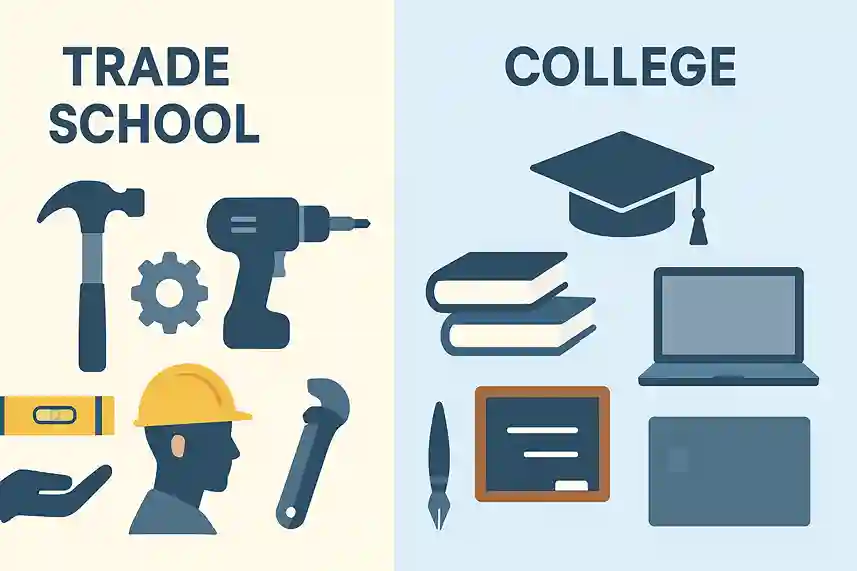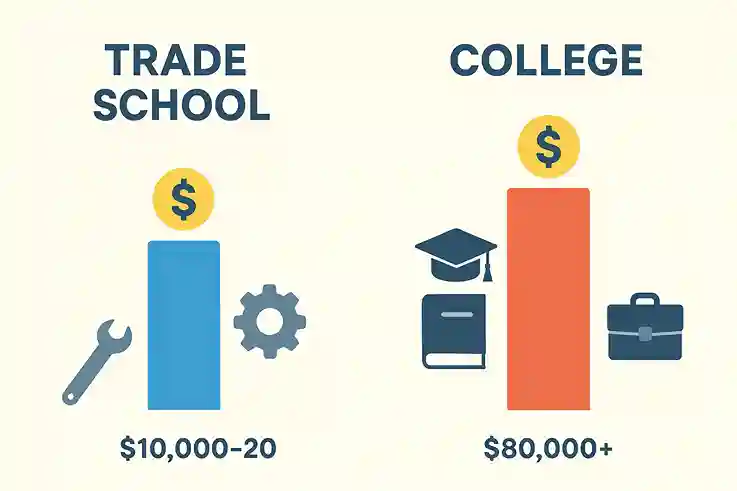Trade School vs College is a decision that influences careers, debt, and overall life direction. It is one of the most important choices students and families face. The path you choose can determine how quickly you enter the workforce, how much debt you carry, and what kind of lifestyle you can build.
Trade schools focus on specialized skills and faster job readiness. Colleges provide a broader education with long-term opportunities. Each path has strengths and drawbacks. Many people pick based on tradition or pressure, without fully comparing the facts. That often leads to regret, especially when student loans or limited job options become overwhelming.
This blog uncovers the practical truths behind both routes. It breaks down costs, time commitments, learning styles, job opportunities, and income potential. You will see how each option fits different goals and personalities. By the end, you will have clear insight to make the choice that works for your future.
Understanding Trade School vs College

A trade school is designed to teach practical skills for specific careers. Programs train students in areas like plumbing, electrical work, automotive repair, or healthcare support. Learning is hands-on and focused, with little time spent on unrelated subjects. Students graduate prepared for immediate entry into their chosen field.
College takes a different approach. It provides a broader education that combines major-specific courses with general subjects like history, writing, or science. This system develops critical thinking, research ability, and long-term adaptability. A degree can open doors to professional roles, management, or advanced studies.
Both paths serve important but different goals. Trade schools build direct skills and faster career entry. Colleges develop broader knowledge and long-term opportunities. The best choice depends on personal interests, learning style, and career vision.
Quick Comparison
- Trade School → 18–24 months, hands-on training, immediate job readiness.
- College → 4+ years, broad learning, wider career flexibility.
Cost of Education: Trade School vs College

Tuition and Fees
Trade schools often charge far less than colleges. Most programs cost between $10,000 and $20,000 in total. This amount usually covers the full training period, which can last from one to two years. Some trade schools also bundle materials, safety gear, or licensing fees into tuition, making costs easier to predict.
In contrast, a four-year college degree can cost $80,000 or more. At private universities, totals may exceed $150,000. Public colleges are more affordable, but tuition still rises every year. Even community colleges, while cheaper, often lead to transfer programs that extend costs. Tuition is only the starting point. Colleges frequently add required fees for labs, student activities, or technology services. Housing and meal plans increase the bill further, sometimes adding $10,000 to $15,000 per year. These extras are not optional for students living on campus.
Trade schools usually avoid these charges. Most do not require housing or meal plans because students live at home or off-campus. The focus stays on direct training, not on campus experiences. This structure keeps the cost of attendance simple and often more manageable for students and families.
Hidden Costs
College expenses go beyond tuition. Textbooks alone can cost $1,000 or more each year, depending on the program. Campus fees for labs, student centers, or recreation facilities also add hundreds of dollars per semester. Technology requirements such as laptops, software, and online access charges increase the bill further.
Living costs are another major factor. Students who live on campus often pay for dorm rooms and meal plans. These can add $10,000 to $15,000 per year. Even students living off-campus face added rent, transportation, and food expenses. Over four years, these hidden costs can equal or exceed tuition itself.
Trade schools operate differently. Programs are shorter and focused only on training needs. Many schools provide necessary tools, uniforms, or protective gear as part of tuition. Some even include exam or licensing fees. By cutting extras, trade schools keep overall expenses lean and predictable. Students know exactly what they are paying for and avoid years of hidden add-ons.
Average Debt Differences
The debt gap between trade schools and colleges is striking. Trade school graduates usually leave with around $10,000 in loans. Because programs are shorter and tuition is lower, repayment is often manageable. Many students finish school and begin earning within two years, which helps them reduce debt quickly.
College graduates often face $30,000 or more in student loans. For those attending private universities, debt can climb past $50,000. Repayment periods stretch into decades, especially when starting salaries are modest. Interest adds to the burden, making the true cost far higher than the original loan amount.
Debt impacts financial freedom. Trade school graduates may buy cars, rent apartments, or even purchase homes earlier. College graduates often delay these milestones while juggling loan payments. Although some degrees can lead to higher long-term earnings, the weight of debt limits choices in the early career years.
Return on Investment
Trade schools offer faster returns. A student can finish in two years, enter the workforce, and start earning. College students may need four or more years before earning full salaries. While lifetime earnings may be higher for some degrees, the early start gives trade school graduates an advantage in the short term.
Cost Comparison: Trade School vs College
| Factor | Trade School | College |
|---|---|---|
| Tuition | $10K–$20K total for most programs | $80K+ for four years (can exceed $150K) |
| Program Length | 1–2 years | 4+ years |
| Hidden Costs | Minimal, often includes tools or fees | Textbooks, campus fees, housing, meal plans |
| Average Debt | About $10K | $30K–$50K+ |
| Debt Repayment | Often cleared within a few years | Can take decades with interest |
| Return on Investment | Faster—graduates earn sooner | Slower—delayed earnings but higher potential ceiling |
Time Commitment: Trade School vs College

Program Length
Trade schools are designed to move students into the workforce quickly. Most programs take between 12 and 24 months. Some specialized certificates finish in under a year, while advanced programs may stretch to two years. The focus is speed and efficiency.
College degrees usually require four years of full-time study. Professional fields such as engineering, law, or medicine can take even longer. Internships, research, or graduate studies may extend the timeline further. For many students, the path to full employment takes five to eight years.
Impact on Career Entry
Shorter timelines mean trade school graduates enter the job market earlier. Many start earning steady incomes in their early twenties. This head start allows them to gain work experience and build financial stability sooner.
College graduates often spend longer preparing before they see returns. By the time they graduate, trade school peers may already have years of job experience. That difference can matter when applying for promotions or securing financial independence.
Flexibility and Career Growth
Colleges provide long-term flexibility. A degree can lead to graduate school, career shifts, or advancement into leadership roles. The broader education supports career changes if industries decline.
Trade schools focus on specific skills, which can limit flexibility. However, demand for skilled trades often remains strong. Many graduates build steady careers without needing advanced degrees. Some also grow into business ownership or supervisory roles, proving that growth is possible outside traditional college paths.
Quick Comparison
| Factor | Trade School | College |
|---|---|---|
| Program Length | 1–2 years | 4+ years |
| Career Entry | Early 20s, faster income | Mid-20s or later |
| Experience Advantage | 2–4 years earlier | Enters later, less early experience |
| Flexibility | Narrow but stable paths | Broad options, career shifts possible |
Job Market Demand and Opportunities

Industries for Trade Graduates
Trade schools prepare students for fields that hire quickly. Industries like construction, electrical work, plumbing, automotive repair, and healthcare support have constant demand. Many of these jobs cannot be outsourced or fully automated, which adds stability. Employers often hire trade graduates immediately after training because practical skills are in short supply.
Opportunities for College Graduates
College degrees open doors to a wider range of roles. Careers in business, finance, education, technology, and science often require a degree. Professional tracks such as law, engineering, and medicine are only accessible with advanced study. While competition is higher, the scope of opportunities is broader for degree holders.
Job Stability Examples
Trade careers often show strong stability. For example, electricians and plumbers remain in demand during economic ups and downs because homes and businesses always need maintenance. Healthcare support roles, like dental hygienists or medical technicians, also show steady growth as populations age.
College degree careers may face more variation. Some fields, like computer science or healthcare administration, are growing rapidly. Others, such as journalism or some areas of liberal arts, show slower growth or limited job openings. Stability often depends on the chosen field rather than the degree itself.
Quick Comparison
| Factor | Trade School Graduates | College Graduates |
|---|---|---|
| Industries | Construction, repair, healthcare support | Business, tech, education, sciences |
| Hiring Speed | Often immediate after training | Slower, usually after graduation |
| Job Stability | High in essential services | Varies by field |
| Growth Path | Steady careers, potential for ownership | Broad roles, management, advanced study |
Job Stability: Real Data, Real Clarity
| Role Type | Projected Growth (2024–34) | Annual Openings | Notes |
|---|---|---|---|
| Electricians (Trade) | 9% | ~81,000 | Much faster than average; high demand |
| Construction Laborers (Trade) | 7% | ~149,400 | Strong growth; steady replacement needs |
| Plumbers/Pipefitters (Trade) | 4% | ~44,000 | Stable demand; replacement-driven openings |
| Bachelor’s Degree Roles | Variable | High in select roles | Broad access, but field-dependent |
- Electricians and construction laborers both show strong hiring demand year after year.
Lifestyle and Learning Style Differences
Hands-On Training at Trade Schools
Trade schools focus on doing rather than just studying. Students spend much of their time in workshops, labs, or on job sites. Training is designed to mirror real-world tasks, such as wiring a circuit, repairing engines, or assisting in medical procedures. This method benefits students who learn best by practice. It also builds confidence because skills are tested daily, not only through exams.
Theory and Research in Colleges
Colleges emphasize theory, analysis, and research. A business major may study economics, management theory, and case studies before applying them in internships. Science majors spend hours in lectures, labs, and research projects to understand principles deeply. This approach builds critical thinking and broad problem-solving skills. Students learn to analyze issues across different contexts, not just in one trade.
Linking Learning Style to Success
Learning style plays a major role in student success. Hands-on learners thrive in trade schools where practice leads to mastery. Students who enjoy exploring concepts, reading, and analyzing data may perform better in college. Matching education style to personal learning preference increases motivation and reduces dropout risks.
Quick Comparison
| Factor | Trade School | College |
|---|---|---|
| Learning Style | Hands-on, practical training | Theory-driven, research-based |
| Daily Work | Workshops, labs, direct practice | Lectures, essays, research projects |
| Skill Development | Focused on one trade or profession | Broad knowledge across multiple subjects |
| Best Fit For | Doers, kinesthetic learners | Thinkers, readers, analysts |
Income Potential: Trade School vs College
Income potential looks very different depending on the path you choose. Trade school graduates often enjoy steady pay early, while college graduates may earn more over time. Trade careers bring quick entry and reliable demand, but degrees can unlock higher salaries in leadership or advanced fields. The table below highlights how starting pay, lifetime earnings, and long-term ceilings compare between the two options.
| Factor | Trade School | College Degree |
|---|---|---|
| Starting Salary | $57K–$83K in fields like trades or HVAC | ~$68K average; varies by major |
| Lifetime Earnings | Lower but consistent starting gains | Higher potential—$600K+ more vs HS diploma |
| Stability & Career Path | Steady demand, quick entry, business routes | Broader options—management, leadership, graduate school |
| Income Ceiling | Moderate to high with experience | High—especially in STEM, management roles |
Pros and Cons: Trade School vs College
Choosing between trade school and college means weighing financial, lifestyle, and career trade-offs. Each path offers unique benefits and limitations. The best option depends on your personal goals, learning style, and long-term vision.
Trade School: Pros and Cons
| Pros | Cons |
|---|---|
| Lower tuition and smaller debt load | Limited career flexibility beyond chosen trade |
| Shorter programs (1–2 years) | Lower lifetime earning ceiling in many fields |
| Hands-on, practical job training | Fewer scholarships or financial aid options |
| Faster entry into the workforce | Some careers require demanding physical work |
| Strong demand in essential industries | Career growth may depend on extra certifications or starting a business |
College: Pros and Cons
| Pros | Cons |
|---|---|
| Broader career options across industries | High tuition and significant student debt |
| Higher potential lifetime earnings | Longer programs—4+ years before full-time work |
| Access to leadership, management, and graduate studies | Risk of underemployment in some majors |
| Strong networking and campus experiences | Less hands-on training, more theory-driven |
| More scholarships and financial aid opportunities | Slower return on investment |
How to Decide What Fits You Best
Choosing between trade school and college is personal. There’s no one-size-fits-all answer. Consider your skills, interests, finances, and long-term goals. Asking the right questions can guide you toward the path that fits your life.
Checklist to Guide Your Decision
What are your career goals?
If your goal is to start earning quickly, trade school is a strong option. Programs focus on hands-on skills, allowing graduates to enter the workforce in one to two years. Jobs in plumbing, electrical work, HVAC, and healthcare support often have immediate openings.
If you want to explore multiple industries or pursue leadership roles, college may be better. Degrees provide broader knowledge, flexibility to switch careers, and access to advanced studies. Knowing your career goals helps balance quick entry versus long-term flexibility and ensures your education matches the life you want.
What is your learning style?
Consider how you learn best. If you thrive in hands-on, practical environments, trade school may suit you. Daily workshops, labs, and real-world practice help you master skills quickly. If you prefer theory, research, and analyzing concepts, college might be a better fit. Lecture-based classes, essays, and projects build critical thinking and broader problem-solving abilities. Matching your learning style to your education path increases motivation, helps you retain knowledge, and improves your chances of success.
How much time can you commit?
Time commitment is a key factor in choosing between trade school and college. Trade programs typically take 1–2 years, allowing students to start working and earning quickly. College degrees usually require four or more years of study, with additional time for internships or graduate programs in some fields. Consider how much time you are willing to invest before entering the workforce and how that fits with your career and life goals.
What is your budget and comfort with debt?
Financial considerations play a major role in choosing education paths. Trade school is typically less expensive, with tuition ranging from $10,000 to $20,000 and minimal hidden costs. College often carries much higher tuition, plus fees, housing, and other expenses, leading to average debts of $30,000 or more. Assess your comfort level with taking on loans and consider how quickly you want to start earning. Your budget may determine which option is realistic and aligns with your long-term financial goals.
Which industries interest you most?
Your industry of choice affects both job security and career growth. Trade careers like plumbing, electrical work, HVAC, and healthcare support often have strong demand and steady employment, even during economic downturns. College degrees open doors to industries like technology, business, healthcare administration, and education, which may offer higher earning potential but can vary in stability. Consider not just your interests, but also the long-term demand, growth potential, and resilience of each field before deciding.
Do you value flexibility and long-term mobility?
College often provides broader career flexibility, allowing you to switch industries, pursue leadership roles, or continue with graduate studies. Trade school, on the other hand, builds specialized skills that lead to faster entry into a specific career. While this expertise can secure steady employment and even business ownership, it may limit options outside that field. Consider whether you prioritize immediate job readiness or the ability to pivot and explore multiple career paths over time.
What motivates you day-to-day?
Understanding your daily motivation can guide your education choice. If you enjoy solving practical problems, applying skills, and seeing immediate results, trade school may be a better fit. If you are energized by analysis, research, and exploring concepts in depth, college might suit you more. Aligning your studies with what drives you daily can increase engagement, help you excel, and make your chosen path more fulfilling over the long term.
Answering these questions honestly can clarify which path aligns with your personality, skills, and life plans.
Conclusion
Choosing between trade school and college is a major life decision. Trade School vs College isn’t about one path being better than the other—it’s about which fits your goals, learning style, finances, and career aspirations. Trade schools offer quick entry, hands-on skills, and lower costs, while college provides broader opportunities, flexibility, and higher long-term earning potential.
Reflect on your priorities, review the pros and cons, and use the checklist to guide your decision. Every path has unique benefits, and the right choice depends on your personal vision for the future.
What factors influenced your education choice? Share your thoughts and experiences in the comments below!

Ellie Clark is a passionate blogger with a specialty in education, where she shares insights on learning methods, study strategies, and ways to make knowledge more accessible. With a background in teaching and a love for lifelong learning, she brings clarity and creativity to her writing, helping readers of all ages unlock their potential. While education remains her core focus, Ellie also writes on a variety of other topics, including lifestyle, travel, and personal development, giving her blog a well-rounded appeal.
When she’s not writing, Ellie enjoys reading, exploring new cultures, and spending time in nature. Her approachable style and thoughtful advice make her a trusted voice for readers seeking both guidance and inspiration.


